
Solar Power
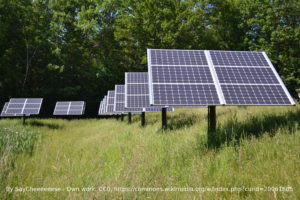
Welcome to Solar Power: The Energy Efficiency Podcast – episode 8, the podcast that brings you a mix of energy efficiency news, products and tips all year round. We’re interested in profiling people and products involved in promoting energy efficiency habits, products and information, so please do get in touch if you have something to contribute.
Before we get on with our advertised features, on Monday morning the Guardian reported on a scheme to generate domestic fuel from dirty plastic waste.
Dirty recycling
Items for recycling should be clean and contain nothing non-recyclable. This is why mixed materials are such an issue. Recyclable materials are wasted and go to landfill if they’re mixed up with non-recyclable materials in the same item. If recycling is dirty it can’t be used.
The worst culprit is food. That’s why silver foil is not usually recyclable. It’s infinitely reusable if it doesn’t get dirty as such, but the foil with bacon fat all over it has to go in the bin. If a householder knows this then contaminated waste won’t enter the recycling foodchain, but mistakes happen all the time. That’s distinct from aspirational recycling, when items go in the green bin in the hopes they can be recycled. Or perhaps the belief that they should. Even paper and glass can be contaminants if they go in the wrong bins. To quote Rubicon Global,
“Contaminants turn your recycling into nothing more than trash.”
This is an entire subject with global repurcussions and one we’ll return to at a later date.
Hydrogen
Help may now be at hand. Work at the University at Chester has been looking at how to use this dirty recycling to create fuel. Researchers have found a way to produce hydrogen. Hydrogen can fuel homes and cars without emitting greenhouse gases. Waste is burnt at 1000 degrees in a glass kiln. The waste instantly breaks down to release gases including hydrogen.
Two waste energy business have come together to develop this research commercially. Later this year production will begin at a plant at Ellesmere Port in Cheshire. Owner of the plant Peel Environmental reckons that a walloping 25 million tons of contaminated recycling will be kept out of landfill and the seas.
Why is hydrogen such a big deal? Hydrogen can take over tasks currently met by traditional gas. Hydrogen can be used for cooking, heating homes and hot water, and fuelling vehicles. It could play a huge part in the UK meeting its climate targets.
There is a downside however. The production of hydrogen emits powerful greenhouse gases including methane. Methane is a disaster, but the plant plans to trap it and use it to generate electricity. The Guardian article describes this process as no “more polluting than the UK’s existing gas-fired power plants”. That’s not a ringing endorsement, but it goes on to make the point that it means no more gas need be pulled from the ground. It highlights again the need for effective carbon capture technology.
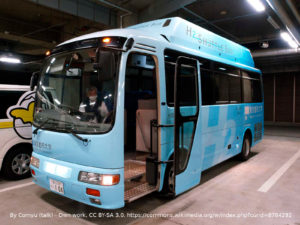
The technology has been developed in collaboration with Asian companies. Hydrogen fuel is already commonly used in Japan, as we looked at in episode 3. Increased production of hydrogen in Asia would make strides in reducing their dependence on coal burning plants. Ep 3 looked closely at fuel use and generation in Japan.
Solar Energy
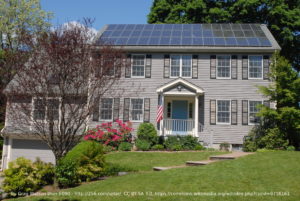 Mid-morning on Monday 22nd July, renewables are providing 15% of the UK’s power requirements. Wind is producing about 2/3 of that, solar power most of the rest. It’s a bright sunny day in parts of the UK and it’s windy. We’re using no coal or oil just now. So would fitting PV panels to your home keep you in electricity all year round? Let’s look at the facts.
Mid-morning on Monday 22nd July, renewables are providing 15% of the UK’s power requirements. Wind is producing about 2/3 of that, solar power most of the rest. It’s a bright sunny day in parts of the UK and it’s windy. We’re using no coal or oil just now. So would fitting PV panels to your home keep you in electricity all year round? Let’s look at the facts.
Photovoltaic cells – PV cells – work by turning sunlight into an electric field. More sunshine means more electricity but PV cells don’t need bright sunlight to generate electricity. They will generate some electricity on a cloudy day. The Energy Saving Trust website says that a typical domestic array could save from 1.3 to 1.6 tonnes of C02 per year. This makes solar panels a better bet in the UK than you might at first assume.
In the UK domestic PV panels are commonly fitted in groups to a roof. The alternative is a roof made up of solar roof tiles. Solar roof tiles are used instead of regular tiles. This will be about twice the price of fitting solar panels. Generally they aren’t as effective and according to the EST are used where there are aesthetic arguments against solar panels.
Suitability
A house must be assessed for the suitability of its location, and the strength and pitch of of its roof. Planning permission might be needed. This usually depends on the size of the proposed installation. A listed building would also likely need listed building consent, similarly a building within a World Heritage Site. Your buildings insurance could be affected, so there are plenty of points to check on if you’re considering solar power. But a roof isn’t the only possible location for solar panels. A solar array can be fitted on the ground, but they are far more susceptible to damage and dirt. Dirty PV cells are less effective simply because less light reaches them.
Although we are looking here mainly at ways of heating your home, solar power offers a standalone water-heating option. Solar thermal panels use the sun’s warmth to directly heat water. This is transferred to your hot water tank. Again they don’t need to be on the roof but they do need good strong direct sunlight. You will need a compatible boiler, but most are compatible. The cost of fitting solar thermal panels is only a little lower than fitting solar panels. In winter the system will likely produce very little if any of your hot water requirements.
Solar panels are a sensible heating solution for off-grid homes. Taking electricity to remote homes is prohibitively expensive, so on-site generation is popular in far-flung locations. With effective storage batteries, combined sources of power and careful use, an off-grid electricity supply can be maintained. However battery systems are very expensive, with the Guardian quoting £4000.
Surplus power
As with other renewables, a householder can sell surplus power back to the grid. Schemes supporting this system have been all over the place in the last couple of years. If you’re planning to fit solar with this in mind, do your homework.
From 2020 the UK government will require most electricity suppliers to offer you something for your power. This is known as the Smart Export Guarantee, SEG. The government blows hot and cold on this. The Feed-In Tariff (FIT), which gave householders producing solar power a payment based on how much they produced, was scrapped in April this year. A 94% drop in installations swiftly followed, according to the Guardian. This follows getting on for a million households having installed solar panels since the launch of the scheme in 2010. Subsidies were slashed in 2016 but rather than expecting its death, supporters had hoped for a replacement.
Set against what can be the high cost of installation, this puts the benefits of lower bills out of reach of most householders. It also takes chunks out of the CCC’s plans to achieve net zero. A solar array might be eligible for the Renewable Heat Incentive, which we looked at last week in relation to ground source heat pumps. VAT on solar panels leaps from 5% to 20% this October.
Cost
Fitting a standard domestic array will cost £6-7000. The price has come down over the last few years. It should last 25 years. In that time the inverter may well need to be replaced. Currently they cost about £800. The inverter changes direct current (DC) into alternating current (AC). We use AC in all appliances in the UK so the inverter is crucial to being able to use the electricity PV panels generate. Inverters are the part most likely to go wrong with a solar installation. When it fails no energy can be produced so the householder immediately loses the benefit of the installation. It can be very expensive to fix inverter problems.
The EST has a graph on its site showing the payback times for different domestic set-ups. It looks at different areas of the country and compares finances with and without the new SEG.
If you can afford to install solar, how much power will it generate?
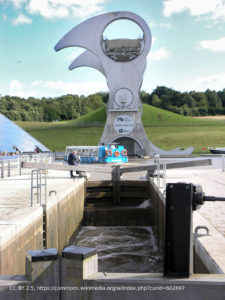
Solar power is measured in kWp – kilowattpeak. This is the maximum power that can be generated by any given installation in the best conditions. It varies from place to place. In southern England a 4kWp installation will generate about 4200 kWh a year. That would turn the London Eye 56 times. In Scotland, traditionally cloudier and wetter (though far from always the case in my experience) the same size array generates about 3,400 kWh. That would turn the Falkirk wheel 2,200. The Falkirk Wheel is a rotating boat lift.
PV panels don’t need much maintenance. They need to stay fairly clean. Make sure they aren’t overshadowed by trees. Birds tend to nest under them. Panels set at 15 degrees or more will be washed clean of debris by rain. The right inclination is important for maximum power generation.
Benefits
Working solar power into a new build provides a number of benefits. When mooted at design stage, the orientation of a roof can be worked in appropriately. Setting the panels in as part of the roof replaces the need for roof covering in that spot. Unusual or awkwardly shaped roofs can be accommodated. Costs are combined and the job done in one fell swoop.
Businesses could be making even more hay while the sun shines. Estimates vary, but fitting PV panels to commercial buildings in the often cloudy and wet UK alone would produce at least 60% of the energy used by business. The majority of businesses are active only in the daytime, when they can get the most benefit from PV panels. Schools, leisure centres and other large buildings are ideal locations for solar panels. This came up last week when we looked at new build sports stadia.
Without an expensive battery system an average house is unlikely to power itself completely by solar energy. The end of the FIT, increasing VAT and delayed introduction of the SEG all make fitting solar a less attractive proposition financially. The rewards will take many years to materialise and most householders will need access to an alternative form of energy as well as solar. If however you want a source of clean and endlessly renewable energy, you have suitable property and can meet the costs, then solar deserves consideration. It is risk-free and low-maintenance. Looking globally, it’s a good option for the billion or so people who live with no access to electricity. The costs shrink to nothing in comparison with the benefit this could bring to healthcare, quality of life and wider opportunities.
Energy efficiency in medicine
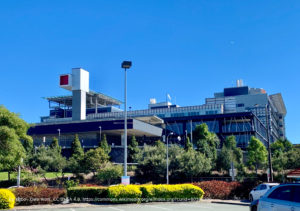
Hospitals are on the go 24 hours a day. They use up to five times as much power as a smart hotel. In the USA hospitals account for 10% of all greenhouse emissions and 40% of that is from heating.
Some medical centres have seen the light. In Wisconsin Gundersen Health System has switched to renewable power. Using wind, biomass, methane gas and manure, it’s reduced its emssions by 95%. Boston Medical Center took a canny look at how it used space. It was able to downsize while increasing patient capacity. It’s installed a cogeneration plant that traps and reuses heat, albeit gas fired, that supplies 40% of its power and provides back-up in a power cut. Theda Clark Medical Center in Wisconsin is saving nearly $1m a year through retrofit measures. It’s installed low-energy lighting, insulated pipes, turned heat exchangers off after hours and switched the lights off in vending machines.
Common sense
As with leisure centres that we looked at last week, medical centres are large buildings with very mixed footfall. The common sense measures used at leisure centres apply to hospitals. Good maintenance, upgrading old kit with energy efficient alternatives, reducing services to little-used parts of the building. This isn’t easy though. Hospitals are usually under such pressure that allocating time to give engineers access to equipment for maintenance or upgrade is difficult.
The Boston example started with an analysis of how the space was used, prior to a redesign. Bob Biggio, hired to oversee the redesign, realised the centre was far bigger than it needed to be. He says “A square foot you never have to build is most efficient of all.” The new smaller premises obviated the need for ambulance transport between departments. It cut power requirements by nearly half!
Biggio sold his plans on the basis of reduced costs and improved health outcomes; the board wasn’t ready to hear about the environmental benefits. As with many sectors, the financial investment has to be weighed against other calls on money. When starting out on a new building however energy efficiency measures fit in to the vision of the future.
Practice Greenhealth
There are about 5000 hospitals in the USA. 1100 belong to Practice Greenhealth, a nonprofit promoting environmental stewardship. Members make about $1m a year each in savings. A simple measure such as switching off heat and light to an unused operating theatre can save $45000 a year. As energy use in a typical hospital accounts for half of all costs, even modest savings add up.
Smart technologies have a central role to play. The Hospital of the University of Pennsylvania has installed a smart air conditioning master unit known as a chiller. It continually monitors temperatures and turns fan on and off. It maximises cooling with minimum energy, and is reaping cost savings. HUP has recruited an energy manager, who is working with other hospitals in the area to bring down energy use.
NHS
 The UK government’s recent 10 year plan for the NHS includes energy efficiency measures. These are many and various, everything from selling off land and buildings to building green homes for NHS staff, and include sensible and straightforward measures such as fitting LED lighting. The NHS is a massive consumer of single-use plastics, eg rubber gloves, medicine packing and instrument wrappings. A new NHS wide procurement body will look to acquire sustainable alternatives affordably. 85% of NHS waste goes to landfill, but the 10 year plan was quiet on how to improve that figure. The plan recognises the impact of ambulances and business travel and aims to reduce it.
The UK government’s recent 10 year plan for the NHS includes energy efficiency measures. These are many and various, everything from selling off land and buildings to building green homes for NHS staff, and include sensible and straightforward measures such as fitting LED lighting. The NHS is a massive consumer of single-use plastics, eg rubber gloves, medicine packing and instrument wrappings. A new NHS wide procurement body will look to acquire sustainable alternatives affordably. 85% of NHS waste goes to landfill, but the 10 year plan was quiet on how to improve that figure. The plan recognises the impact of ambulances and business travel and aims to reduce it.
A whopping 50% of all patients don’t take their medicines correctly. The sheer volume of wasted medicine goes unquantified. 10% of hospital admissions among the over-65s is due to meicine misuse. In response routine prescribing of paracetamol, bandages and other items easily obtainable over the counter will cease.
George Davies Centre
The George Davies Centre at the University of Leicester is the UK’s largest non-domestic passivhaus building. This teaching and medical facility features a living wall. Automatic blinds control solar gain and loss. Scaling up passivhaus to a building of this size and complexity was a huge challenge involving a number of agencies, but it has paid off. The building is five times more efficient than comparable higher education buildings. Older inefficient buildings have closed and the George Davies building is in use for longer hours. Emissions drop and students and visitors spend more time in a more comfortable building.
James Elliment who works for construction partner Willmott Dixon, says,
“Through the three-year soft landings process, we have been able to really understand how to use the building as efficiently as possible. Part of this has involved working very closely with the building’s users to educate them about how the building functions – explaining why the lights automatically dim, how the radiators know when it is too cold and when blinds close themselves, so that the building can perform to its optimum levels. Without this education the performance gap and payback period grow, which is something we have worked to avoid.”
Some of the environmental changes have taken a bit of getting used to. Willmott Dixon has monitored the building’s performance and user experience to achieve the best outcome for everyone. As the building’s use evolves the energy use and requirements must be kept under review. Elliment goes on to say:
“George Davies Centre is one of the lowest energy facilities of its kind in the country and has illustrated beyond doubt that it is possible to meet the challenges of energy reduction while developing an estate and highlighted the importance of working with users throughout the process. This project is exemplar and a benchmark for developments of this scale. It continues to turn heads across both the higher education and construction sectors.”
Living roofs
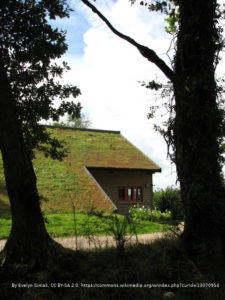 We touched on living roofs last week as part of the feature on passive cooling. As mentioned just now, a living roof is one aspect of keeping a building insulated. As the planet warms it’s easy to think of this in terms of keeping cool, but for hundreds of years Icelandic houses used turf roofs as insulation from the cold. Turf roofs were still common in Scandinavia 150 years ago. So living roofs aren’t new, but as a modern architectural feature they began to take off in the 1960s.
We touched on living roofs last week as part of the feature on passive cooling. As mentioned just now, a living roof is one aspect of keeping a building insulated. As the planet warms it’s easy to think of this in terms of keeping cool, but for hundreds of years Icelandic houses used turf roofs as insulation from the cold. Turf roofs were still common in Scandinavia 150 years ago. So living roofs aren’t new, but as a modern architectural feature they began to take off in the 1960s.
Many of the benefits of a green roof are pretty much immediately obvious. They’re easy on the eye, breaking up expanses of concrete and tile. They absorb rainwater – 75% of summer rainfall and 40% of winter. That water would otherwise have contributed to run-off and possibly flooding. The plants use the water, and the rest evaporates back out into the atmosphere slowly. This is one way that green roofs break up the heat island effect. They provide habitat for insects and birds and often include beehives. They provide insulation from noise, heat and cold. There has even been a suggestion that they might house herds of cows by the end of this century.
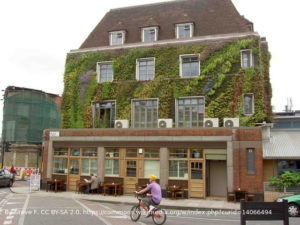 A green roof policy was first included in a London Plan in 2008. In April this year the report Living Roofs and Walls, from policy to practice, revealed that there are now 1.5m square metres of green roof and wall in London. This outstrips cities such as Copenhagen, Toronto and Singapore. Over 40% of the green roof space in the country is in London, arguably where it’s needed most. This has been achieved without subsidies. In those 10 years a body of evidence has grown to support the use of green roofs.
A green roof policy was first included in a London Plan in 2008. In April this year the report Living Roofs and Walls, from policy to practice, revealed that there are now 1.5m square metres of green roof and wall in London. This outstrips cities such as Copenhagen, Toronto and Singapore. Over 40% of the green roof space in the country is in London, arguably where it’s needed most. This has been achieved without subsidies. In those 10 years a body of evidence has grown to support the use of green roofs.
Categories
All green roofs are not equal. They often include a mix of vegetation, soil, sand and rock. Green roofs are divided into two categories: intensive and extensive, referring to the level of maintenance required. An intensive green roof usually requires irrigation and several maintenance visits a year. They can be formally laid out and some grow produce. Extensive green roofs consist of slow-growing low-growing drought-tolerant vegetation. They require little maintenace and won’t be irrigated after getting established.
Some roofs are designed to store water, a blue green roof, others solar panels, a biosolar roof. Living walls are also divided into categories depending on their characteristics. These include bioactive facades. In these materials are developed to encourage the growth of organisms such as moss. They are designed for areas where more profuse foliage wouldn’t work.
The report evaluated green roofs and walls against seven criteria:
- Surface water management
- Urban cooling
- Biodiversity
- Air quality
- Health and wellbeing
- Noise reduction
- Potential for carbon sequestration
In not one category did living roofs and walls not make an improvement.
Mandatory
An article in PlaceNorthWest in September last year argued the case for mandatory green roofs in Manchester. The article makes the point that green roofs shouldn’t be slapped on a building as an afterthought green measure, saying:
“Just as natural landscapes are a composition of varying habitats and ecosystems, the role of green roofs is to contribute to a wider cityscape of green infrastructure, encompassing trees, parks, gardens, bio-swales and green walls.”
The author, Andrew Watson, associate landscape architect at Optimised Environments, emphasises the role green roofs and walls can play as the climate warms. In his experience, plans for a green roof often wall by the wayside as a development continues. He blames this on green roofs not being included in planning frameworks outside London. Amsterdam and New York are among cities that offer subsidies and tax breaks for green roofs. 25 North American cities have passed legislation requiring green roofs or incentivising them.
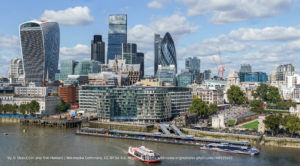 The City of London might not seem the obvious place for green roof success stories, but there are quite a few. In 2011 the City of London Corporation published a set of case studies including at The Museum of London. The document describes the Museum as “leading by example in innovative and diverse green roof areas”. MoL uses its green roof as a teaching resource. The green roof was put in during essential roof replacement works.
The City of London might not seem the obvious place for green roof success stories, but there are quite a few. In 2011 the City of London Corporation published a set of case studies including at The Museum of London. The document describes the Museum as “leading by example in innovative and diverse green roof areas”. MoL uses its green roof as a teaching resource. The green roof was put in during essential roof replacement works.
There can be downsides. The green roof on New Court, St Swithin’s Lane, part of the Rothschild’s banking business, attracted seagulls. To try to combat this owl statues were placed on the roof. The report doesn’t comment on their effectiveness. Interestingly, the rundown on New Court mentions that living roofs are now often a requirement of development in the city. In this instance inclusion of a living roof contributed to granting of permission for the construction.
Buses
But why restrict yourself to green roofs on buildings? In Singapore 10 buses have been fitted with living roofs. This is a trial to see whether living roofs will keep buses cooler for passengers. In Brussels a mobile living wall removes pollutants from the air. In Kuala Lumpur planting cools bus stops and helps to purify the air.
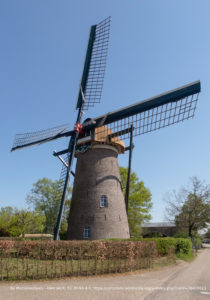 In Utrecht in the Netherlands bus stop planting has been designed specifically for bees. The planting is looked after by a group of caretakers who travel in an electric van.
In Utrecht in the Netherlands bus stop planting has been designed specifically for bees. The planting is looked after by a group of caretakers who travel in an electric van.
Utrecht plans to power a fleet of electric buses by windmill-generated power. A local scheme offers funding to householders to create living roofs. Where there’s a will, things happen.
What are we up to? We’re working on images and web updates at the moment. We’re developing our plans for a microchip reader for the door. We haven’t fitted them to date as we need to be absolutely certain the technology won’t let us down. We still haven’t found reliable enough technology but we’re working on how the parts will work with our manufacturing. We expect the solution we eventually come up with to be a retrofit measure too.
Thank you for listening to episode 8 of the Energy Efficiency Podcast, available through Apple Podcasts. Until next time you can find us on both Twitter and Instagram as Ecoflap, and on Twitter we also tweet under The Petflap. In next week’s episode we’ll look at energy efficiency when you have a baby, wind power, and transition towns.
Music credit: “Werq” Kevin MacLeod (incompetech.com)
Licensed under Creative Commons: By Attribution 3.0 License
http://creativecommons.org/licenses/by/3.0/
